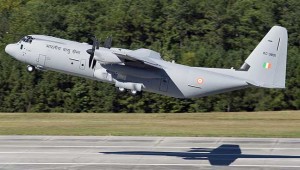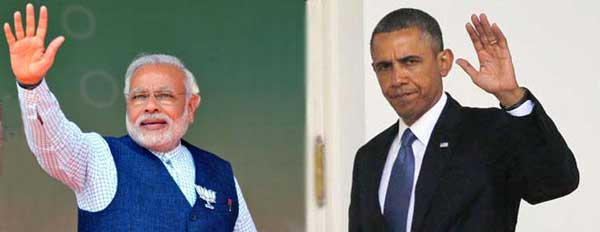Today, the India-US relationship is a transformed one with the change in Indian thinking about America being the most important element. Being ‘pro-American’ is not a stigma any longer whether in politics or business. The wider public accepts that establishing good relations with America is a desirable objective. Pragmatic thinking in India supports the inclination of the government to bring India and the US closer, though not at the cost of becoming subservient to the latter.
US-India Geo-political Convergence?
Is there a geo-political coherence in the India-US partnership that can be delineated on the ground by tracing a curving line across the globe or a sizable part of it that connects points of convergence? Where will this arc begin? In what we call West Asia? Will it begin in Afghanistan and go eastwards? Or will it begin in Thailand and go right through South-East Asia and end up in Japan? Does the arc begin in the Indian Ocean and go right up to the South China Sea? Such a line would confine the scope of the India-US relationship to the Asia-Pacific region largely, now the focal point of US geo-strategic interest in the wake of China’s rise.
What about the so-called global issues? Can they be connected coherently with an arc of partnership? Issues connected with climate change concerns, environmental issues, democracy, human rights, non-proliferation, terrorism and religious extremism. Is there enough convergence between the two countries on these issues?
In many ways, India’s most difficult relationship with any country has been with the US, the foremost global political, economic and military power. Over decades the US has curbed India strategically by imposing sanctions in the critical areas of nuclear and space technologies, and high-technology in general. India has felt US pressure on the issue of human rights. Our democracy may have shielded us from the worst, but on the positive side it has brought no particular bonus.
The US has bolstered Pakistan. Its strategic outreach to China from the 1970s added to our problems by exposing us to joint pressure from Pakistan and China, with the US overlooking some of the worst proliferation activity by the two that today puts constraints on US efforts to restrain Pakistan’s conduct on issues of terrorism and religious extremism.
The US approach to terrorism and religious extremism had been ambivalent until 9/11, at India’s cost because the US has, over the years, ignored Pakistan’s use of terrorism as an instrument of state policy because India, not the US, was principally the victim. India’s view, that terrorism had to be viewed and fought against as a global phenomenon, obtained no support.
Shift in US-India Perceptions
Today, the India-US relationship is a transformed one with the change in Indian thinking about America being the most important element. Being ‘pro-American’ is not a stigma any longer whether in politics or business. The wider public accepts that establishing good relations with America is a desirable objective. Pragmatic thinking in India supports the inclination of the government to bring India and the US closer, though not at the cost of becoming subservient to the latter.
The urbanised Indian middle class is very positively oriented towards the US, and so is the entrepreneurial class, especially that section involved in the knowledge economy. The business community as a whole, that today wields far more influence on policy making because of the liberalisation of the Indian economy and the declining role of the state sector, is an engine for the growth of Indo-US ties. The media devotes a lot of attention to the US. In any report card of the relationship over the last decade this change in attitude is not only very important, it is key to a progressively enhanced relationship with the US in the years ahead.
The evolving defence relationship with the US reflects this change in attitude. The US continues to arm Pakistan, and India, though unhappy, is willing to take a broader view of shared interests. Currently, the US has bagged the largest number of arms contracts – about $8 billion worth in the last five years – despite the stringent and intrusive end-use monitoring requirements. India is likely to order more C-17s and P-8I aircraft. The contract for attack helicopters and light howitzers could well go to the US too. India no longer allows fears of a cut-off of US arms supplies in the event of regional tensions to stand in the way of enhanced defence ties.
 The elimination of US fighters from the competition for the MMRCA contract, which continues to rankle feelings in the US, is not a defining decision. The US expected a political decision in its favour, whereas India wanted to insulate the decision from politics and base it primarily on technical and financial considerations. Despite our exceptionally close ties with Russia historically, the Russians too were eliminated from the MMRCA competition. In the area of military-to-military cooperation India and the US have organised numerous exercises, over 50 in the last seven years. With no other country have the Indian armed forces engaged in so many joint exercises. This is an important building block of mutual confidence. In the larger security related context, the US decision to liberalise export controls for India and lifting sanctions on some of our entities are important steps towards building a partnership.
The elimination of US fighters from the competition for the MMRCA contract, which continues to rankle feelings in the US, is not a defining decision. The US expected a political decision in its favour, whereas India wanted to insulate the decision from politics and base it primarily on technical and financial considerations. Despite our exceptionally close ties with Russia historically, the Russians too were eliminated from the MMRCA competition. In the area of military-to-military cooperation India and the US have organised numerous exercises, over 50 in the last seven years. With no other country have the Indian armed forces engaged in so many joint exercises. This is an important building block of mutual confidence. In the larger security related context, the US decision to liberalise export controls for India and lifting sanctions on some of our entities are important steps towards building a partnership.
India’s Stand on India-US Congruence
Despite these positive trends India, however, remains cautious about developing operational cooperation with the US because of its political implications, both in terms of domestic politics and India’s external ties. India wants to develop broad-based mutually beneficial relations with various global power centres rather than being seen as excessively leaning towards one power centre. No doubt there are many values that draw India and the US together such as the spread of democracy, pluralism, respect for human rights and entrepreneurial freedom.
The problem lies in the methods used to promote these positive values. The West, led by the US, is prone to use military means to promote or even impose these and often selectively. Authoritarian friends are protected and authoritarian adversaries targeted. India does not want to be caught in a situation in which it becomes party to a selective application by the US of principles that are, in themselves, positive. As it happens, it is Russia and China that are the principal hurdles in the United Nations Security Council in denying the US and her allies a free hand to change regimes they dislike for geo-political reasons.
Often these regimes are unsavoury but the issue is not that they might be disreputable, it is the management of international relations in a consensual and equitable manner, with due respect accorded to sovereignty and the principle of non-interference in the internal affairs of countries. If governments should not have total immunity for heinous crimes against their own populations because of the sovereignty principle, neither should such crimes be exaggerated and amplified by the West-controlled international media to justify intervention, nor should other reasons be trumped up for mobilising support for regime change.
India is therefore unwilling at this juncture to sign some pending defence agreements with the US that might be construed as opening the door for operational cooperation. The LSA for logistics, CISMOA for inter-operability and BECA for geo-spatial cooperation have been shelved for the time being. India does not perceive any particular advantage in these agreements.
Recent Developments in Iran
Developments relating to Iran illustrate the kind of problems India can be confronted with if certain expectations of India-US congruence in policies are raised with an expanded defence relationship. India has no reason to support either US military action against Iran or steps at economic strangulation. Even on the central issue of Iran’s nuclear programme, India can hardly view the situation in as catastrophic as the US would want us to. US hands on the nuclear issue with India have not been clean. Worse, it has deliberately overlooked Pakistan’s nuclear activity in connivance with China in the past and continues to do so even today.
However reprehensible Iran’s conduct, Pakistan’s has been far worse from our point of view as it directly affects our security, which the Iranian programme does not. Already our efforts to preserve our energy relationship with Iran have become a contentious issue with the US. So long as the strategic visions of India and the US in our region in particular are not sufficiently aligned, our defence relationship will be subject to political limits.
Impediments in Indo-US Nuclear Cooperation
The Indo-US nuclear deal has been at the fulcrum of the changed India-US relationship, though the process was politically painful. Despite the non-proliferation caveats it contained and the sharp controversy they provoked at that time, that criticism has subsided. Now the attention is on realising actual commercial benefits from the nuclear agreement.
Here, the Indian Nuclear Liability Act has put a spoke in the wheel for US nuclear suppliers. India believes its act is compliant with the Convention on Supplementary Compensation, whereas the US does not. The US has been pressing India to ratify the CSC which India has committed to doing by the end of the year but the US demand that this be done in active consultation with the IAEA has not been acceptable to India. It is by no means clear that with such ratification India’s international obligations will override its domestic law. In any case, India has failed to ratify the CSC as promised. On the other hand, India has drafted the regulations under the Liability Act and placed them before the Parliament.
These regulations limit supplier liability financially and in duration, but their finalisation awaits the disposal of an amendment that has been proposed. It appears that the US is still not satisfied with the effective dilution of the liability provisions of the Act in the regulations that have been framed and would want India to still conform to the so-called international practice of placing all liability on the operator. Meanwhile, an ‘early works agreement’ between US companies and NPCIL is being proposed but substantial progress on setting up US supplied plants can only be made after commercial negotiations are completed on a viable tariff for the power produced.
The problem of liability has been compounded politically by the Fukushima disaster and anti-nuclear protests in India that threaten even to delay the commissioning of the almost ready Russian-built nuclear power plant at Kudankulam. The French site at Jaitapur has run into problems with local communities. Another Russian site at Haripur in West Bengal has been abandoned. The India-Japan nuclear negotiations too have suffered because of Fukushima. All this does not augur well for US companies.
The lack of progress on the nuclear power front has raised the issue of deliverables by Indian in return for US leadership in bringing India out of the nuclear cold. To some extent, this is regrettable because if the nuclear deal was strategic in intent, it should not be reduced to a transactional one. In other words, it should not be seen that the deal was primarily intended to open doors for US companies to secure lucrative Indian contracts, even though this would have been a natural outcome. While it is legitimate for US companies to actively push their commercial interests, to assume that India is obliged to reward the US through its companies and failure to do so in time is grounds for grievance, would be a mistaken notion. Lack of progress should not, hopefully, cause the US to slow down in the implementation of the other steps envisaged to normalise as far as possible India’s status as a responsible non-NPT nuclear power by making it a member of the NSG, MTCR, the Australia Group and the Wassenaar Arrangement.
The US attitude towards China’s decision to supply two additional nuclear reactors to Pakistan, is troubling for us. India has refrained from making an issue of it to avoid differences on nuclear issues with the US when after decades of contention both countries have resolved their bilateral differences over India’s nuclear programme. India has also wanted to avoid a diplomatic dispute with Pakistan as well as China on this issue for its own reasons, namely, to avoid disrupting the on-going dialogue with Pakistan and in recognition of the futility of raising the issue with China. With the US/West showing complacency over this China-Pakistan agreement, India, as a non-member of the NSG, had additional reason to avoid inviting a diplomatic rebuff in agitating the issue.
In view of US concerns about the safety of nuclear materials and the world-wide initiative it has taken to galvanise action on this front globally, one should have expected the US to have shown more concern than it has about the security of the fast expanding Pakistani nuclear arsenal, particularly as the country is falling prey to religious extremism and terrorism. The US should be fearful of the danger of nuclear material falling into the hands of extremist elements not necessarily from outside the system. The powerful anti-US wave sweeping Pakistan should intensify these concerns. The US could have, therefore, done more to oppose this inopportune China-Pakistan deal. Critics construe the relatively complacent attitude of the US as intended to allow Pakistan some satisfaction through China to balance the nuclear deal with India in the face of persistent Pakistani demands for a similar deal from the US for itself.







So, India wants to be friends with USA? That’s funny! All the while, though, all that Indians do is chastise and criticize and blame USA for every problem and ailment in the world. Indians also disrespect the voices and opinions of NRI Indians settled overseas, which I think is out of pure jealousy. This is not the way to run a partnership. You can’t claim to be friends or want to be friends if you hate Americans and America. This is true hypocrisy which is seen through by the Americans. That is why USA can’t seem to trust India and the relationship has faltered. The true transformation in friendship will only come when Indians in India have a change of HEART.
For any meaningful defence partnership with the USA, India should insist on USA committing itself to the territorial integrity of India.